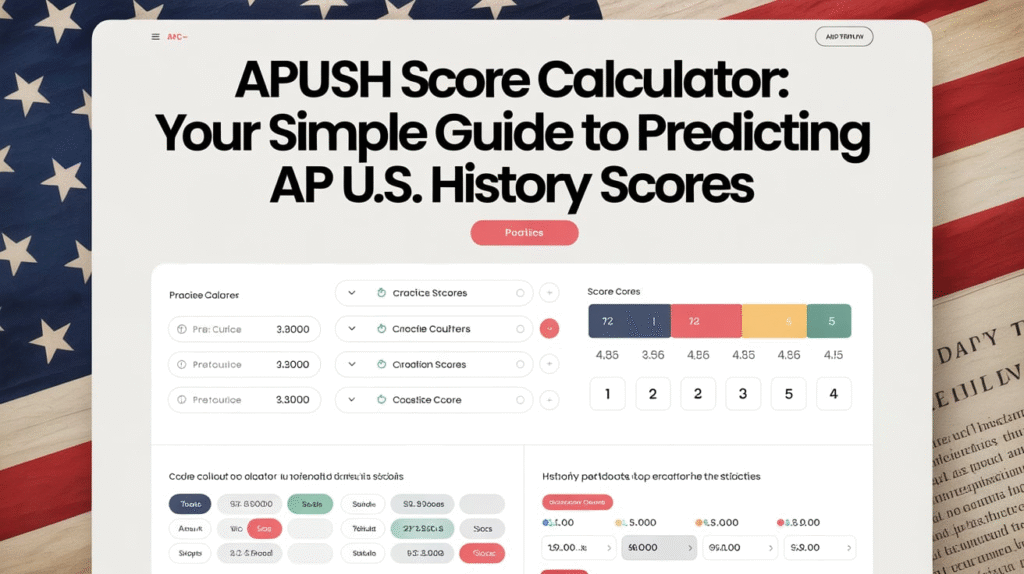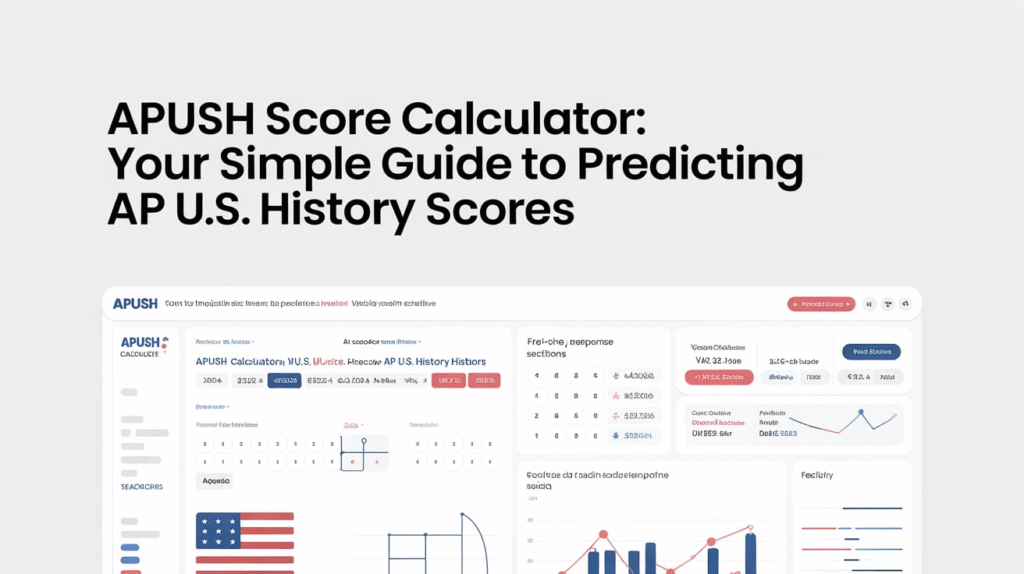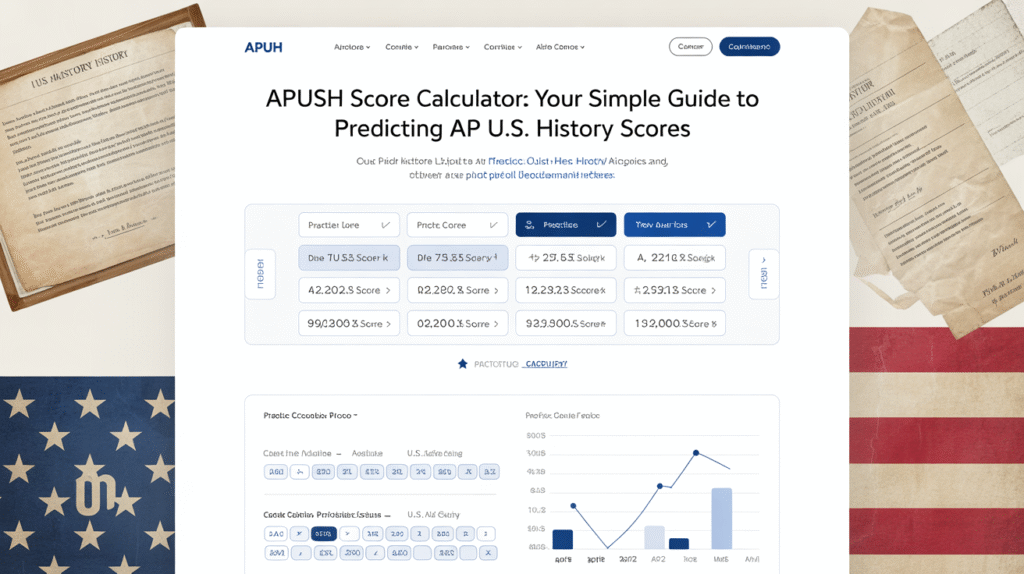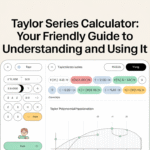If you’re taking AP U.S. History (APUSH), you already know how much information there is to remember. Dates, people, battles, laws—it’s a lot! After months of studying, you probably wonder, “How well will I score on the AP exam?”
That’s where an APUSH score calculator comes in handy. It helps you estimate your exam score based on your practice test results. With a few clicks, you can see if you’re on track for a 3, 4, or even that perfect 5.
In this guide, we’ll break down everything you need to know about the APUSH score calculator, how it works, and how you can use it to improve your chances of success.
What Is the APUSH Score Calculator?

The APUSH score calculator is a free online tool that predicts your final AP U.S. History exam score. It uses your multiple-choice and free-response results to estimate how the College Board might grade your test.
You enter your section scores, and the calculator does the math—giving you an idea of whether you’d earn a 1, 2, 3, 4, or 5. It’s not an official score, but it’s surprisingly accurate.
Think of it like a practice scoreboard for your studying journey. It helps you see how ready you are before exam day.
Why the APUSH Exam Matters
The APUSH exam isn’t just another history test. It’s a chance to show your deep understanding of American history and even earn college credit.
A strong score—usually a 4 or 5—can save you hundreds of dollars in college tuition. Many universities accept APUSH scores for introductory history courses. That means less time and money spent later!
By using an APUSH score calculator, you can check your progress and stay motivated as you prepare.
How the APUSH Exam Is Scored

Before understanding how the APUSH score calculator works, it’s helpful to know how the exam is graded.
The AP U.S. History test has two main parts:
- Multiple-Choice and Short-Answer Section (Section I)
- Free-Response Section (Section II)
Each part counts toward your total score out of 100 points.
- The multiple-choice section has 55 questions worth 40% of your total score.
- The short-answer and essay sections (DBQ, LEQ) make up the other 60%.
The College Board converts your total points into a 1–5 score scale. The APUSH score calculator follows the same formula to estimate your result.
How to Use an APUSH Score Calculator Step by Step

Here’s how to use an APUSH score calculator in just a few minutes:
- Find a reliable calculator. Sites like Albert.io, CrackAP, or APClassroom have versions you can use for free.
- Enter your multiple-choice results. For example, if you answered 35 out of 55 questions correctly, type that in.
- Add your essay scores. You’ll usually enter your DBQ (Document-Based Question) and LEQ (Long Essay Question) points.
- Click “Calculate.” The tool will instantly show your projected AP score.
That’s it! You’ll get an idea of where you stand and which areas need more focus before the big day.
What the Different APUSH Scores Mean
The APUSH score calculator gives you a score from 1 to 5. Here’s what each number means:
- 5 – Extremely Well Qualified: You’ve mastered the material! Many colleges will give you credit.
- 4 – Well Qualified: You’re in great shape. Some colleges will accept this for credit.
- 3 – Qualified: You passed! It shows solid understanding, though some colleges may not grant credit.
- 2 – Possibly Qualified: You’re close but may need more review.
- 1 – No Recommendation: Keep studying—this is your chance to grow and improve.
Using a calculator helps you identify whether you’re ready for that top-tier score or need a little more practice.
Why Use an APUSH Score Calculator Early?
Most students wait until the last few weeks before using the APUSH score calculator, but that’s a mistake.
Try using it early in your study plan—maybe after your first practice test. This gives you time to improve your weak spots.
For example, if your calculator result shows your essays are lowering your score, you can spend extra time on writing practice. You’ll see your progress grow each time you retest.
How Teachers and Tutors Use the Calculator
Teachers love the APUSH score calculator because it helps them track student progress. Many APUSH teachers use it after each mock exam to see how the class is performing.
Tutors also use it to create personalized study plans. If a student scores low on multiple-choice but high on essays, the tutor can adjust lessons to strengthen those weaker areas.
It’s not just for students—it’s a powerful planning tool for educators too.
When to Use the Calculator During the Year
You don’t have to wait until May to check your score estimate. Here’s a good timeline:
- Fall: Take a short diagnostic test and use the APUSH score calculator to see your baseline.
- Winter: Check again after your midterms or review sessions.
- Spring: Use it with full-length practice exams to predict your final performance.
Regular use keeps you accountable and confident leading up to test day.
Tips to Improve Your APUSH Score
A calculator is only as useful as the work you put in. Here are some study tips that can help you raise your score:
- Focus on cause and effect. APUSH questions often ask why something happened, not just what happened.
- Practice document analysis. The DBQ rewards clear, evidence-based arguments.
- Review past exams. Learn from real APUSH questions available on the College Board website.
- Take timed tests. The exam is long, and pacing matters a lot.
- Use the APUSH score calculator often. Watch your progress climb as you improve your weak areas.
Each time you test and calculate again, you’ll see your growth in real numbers.
How Accurate Are APUSH Score Calculators?
Most APUSH score calculators are based on real scoring data from previous years. While they can’t be 100% exact, they’re usually close—often within a few points of your actual score.
That’s because the College Board sometimes changes the score cutoffs slightly each year. But the calculators still give a very good estimate, especially for practice purposes.
Think of them as your personal score thermometer. They show your overall temperature, even if it’s not exact to the decimal.
Real Example: Using the Calculator in Practice
Let’s say you take a full practice test and get:
- 35 out of 55 on multiple choice,
- 6 out of 7 on the DBQ,
- 5 out of 6 on the LEQ, and
- decent short-answer scores.
You plug these into an APUSH score calculator, and it predicts a score of 4. That tells you you’re on track for a strong result—but there’s still room to reach that perfect 5.
By focusing on multiple-choice review, you can raise your practice results and retest again later.
Choosing the Best APUSH Score Calculator
Not all calculators are equal. Look for tools that are:
- Updated regularly (reflecting recent exam scoring changes)
- Based on official scoring guidelines
- Easy to use with clear input fields
- Backed by educational platforms like Albert.io, CollegeVine, or APClassroom
Avoid sketchy sites that promise “exact scores” or ask for personal data. Stick with trusted educational resources.
Related Tools for AP Students
The APUSH score calculator isn’t the only tool that can help you prepare. There are calculators for other AP subjects too—like AP World History, AP Government, and AP European History.
If you’re taking multiple AP classes, these calculators can help you manage your time wisely. You’ll know which subjects need the most focus.
Using them together gives you a full view of your AP exam readiness across the board.
Common Mistakes to Avoid
Here are a few common mistakes students make with the APUSH score calculator:
- Relying on it too much. It’s a guide, not a guarantee.
- Entering wrong data. Make sure you count your correct answers carefully.
- Ignoring feedback. If your predicted score is low, don’t panic—use it to plan better study sessions.
- Not using it enough. Tracking progress over time gives you a clearer picture than one test alone.
Used wisely, it’s one of the best free tools for APUSH prep.
FAQs About the APUSH Score Calculator
1. Is the APUSH score calculator official?
No, it’s not official. It’s made by educators who use College Board scoring data to estimate results.
2. Can I use it for all practice exams?
Yes! You can use it with any APUSH practice test, as long as you know your correct answers and essay scores.
3. How often should I check my score?
Try using the calculator after every full practice test—maybe once a month as you prepare.
4. What if my score is low?
Don’t worry! Use your calculator results to see which section needs work and adjust your study plan.
5. Are calculators free to use?
Yes, most APUSH score calculators online are completely free and require no login.
6. Does the calculator help with motivation?
Absolutely. Watching your score predictions rise can keep you motivated to keep studying hard.
Final Thoughts: Use the APUSH Score Calculator as Your Study Buddy
The APUSH score calculator isn’t just a number-crunching tool—it’s your study companion. It shows where you stand, where to improve, and how close you are to reaching your goals.
When used regularly, it helps you track real progress, stay motivated, and enter exam day with confidence.
So go ahead—grab your latest practice test, open your favorite APUSH score calculator, and find out how ready you really are. Every click brings you closer to your best possible score!



